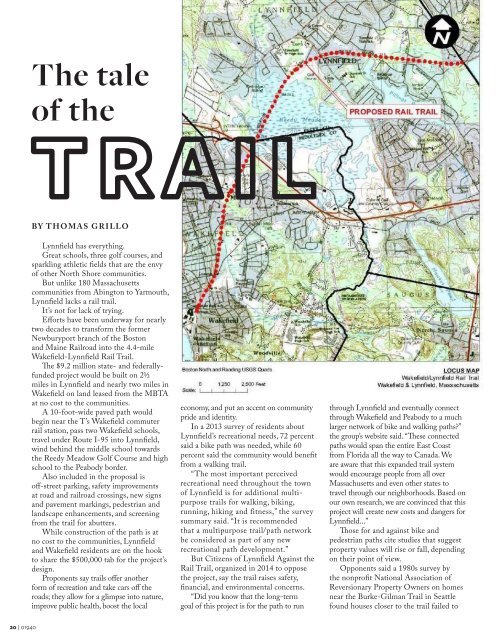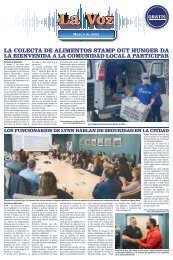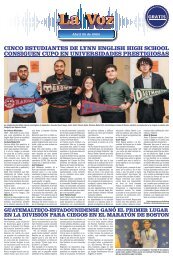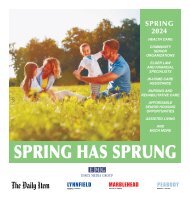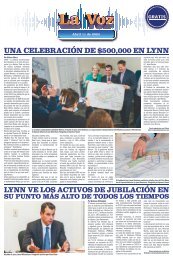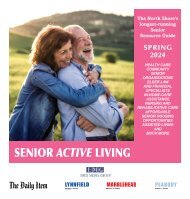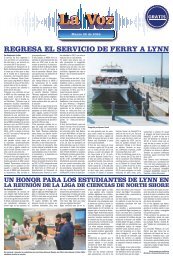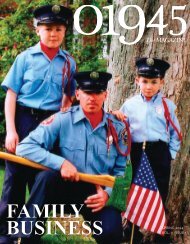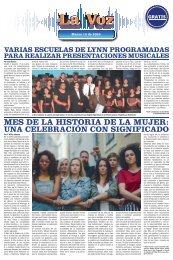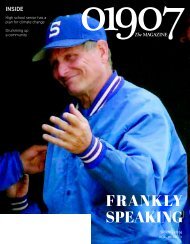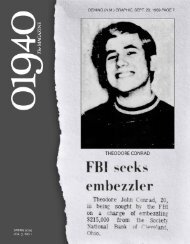You also want an ePaper? Increase the reach of your titles
YUMPU automatically turns print PDFs into web optimized ePapers that Google loves.
The tale<br />
of the<br />
BY THOMAS GRILLO<br />
Lynnfield has everything.<br />
Great schools, three golf courses, and<br />
sparkling athletic fields that are the envy<br />
of other North Shore communities.<br />
But unlike 180 Massachusetts<br />
communities from Abington to Yarmouth,<br />
Lynnfield lacks a rail trail.<br />
It’s not for lack of trying.<br />
Efforts have been underway for nearly<br />
two decades to transform the former<br />
Newburyport branch of the Boston<br />
and Maine Railroad into the 4.4-mile<br />
Wakefield-Lynnfield Rail Trail.<br />
The $9.2 million state- and federallyfunded<br />
project would be built on 2½<br />
miles in Lynnfield and nearly two miles in<br />
Wakefield on land leased from the MBTA<br />
at no cost to the communities.<br />
A 10-foot-wide paved path would<br />
begin near the T’s Wakefield commuter<br />
rail station, pass two Wakefield schools,<br />
travel under Route I-95 into Lynnfield,<br />
wind behind the middle school towards<br />
the Reedy Meadow Golf Course and high<br />
school to the Peabody border.<br />
Also included in the proposal is<br />
off-street parking, safety improvements<br />
at road and railroad crossings, new signs<br />
and pavement markings, pedestrian and<br />
landscape enhancements, and screening<br />
from the trail for abutters.<br />
While construction of the path is at<br />
no cost to the communities, Lynnfield<br />
and Wakefield residents are on the hook<br />
to share the $500,000 tab for the project’s<br />
design.<br />
Proponents say trails offer another<br />
form of recreation and take cars off the<br />
roads; they allow for a glimpse into nature,<br />
improve public health, boost the local<br />
economy, and put an accent on community<br />
pride and identity.<br />
In a 2013 survey of residents about<br />
Lynnfield’s recreational needs, 72 percent<br />
said a bike path was needed, while 60<br />
percent said the community would benefit<br />
from a walking trail.<br />
“The most important perceived<br />
recreational need throughout the town<br />
of Lynnfield is for additional multipurpose<br />
trails for walking, biking,<br />
running, hiking and fitness,” the survey<br />
summary said. “It is recommended<br />
that a multipurpose trail/path network<br />
be considered as part of any new<br />
recreational path development.”<br />
But Citizens of Lynnfield Against the<br />
Rail Trail, organized in 2014 to oppose<br />
the project, say the trail raises safety,<br />
financial, and environmental concerns.<br />
“Did you know that the long-term<br />
goal of this project is for the path to run<br />
through Lynnfield and eventually connect<br />
through Wakefield and Peabody to a much<br />
larger network of bike and walking paths?”<br />
the group’s <strong>web</strong>site said. “These connected<br />
paths would span the entire East Coast<br />
from Florida all the way to Canada. We<br />
are aware that this expanded trail system<br />
would encourage people from all over<br />
Massachusetts and even other states to<br />
travel through our neighborhoods. Based on<br />
our own research, we are convinced that this<br />
project will create new costs and dangers for<br />
Lynnfield...”<br />
Those for and against bike and<br />
pedestrian paths cite studies that suggest<br />
property values will rise or fall, depending<br />
on their point of view.<br />
Opponents said a 1980s survey by<br />
the nonprofit National Association of<br />
Reversionary Property Owners on homes<br />
near the Burke-Gilman Trail in Seattle<br />
found houses closer to the trail failed to<br />
20 | <strong>01940</strong>


